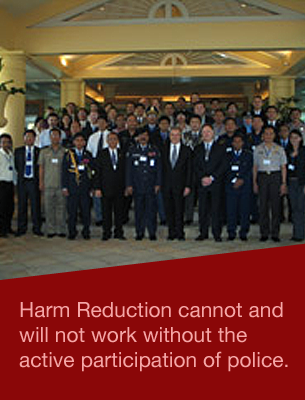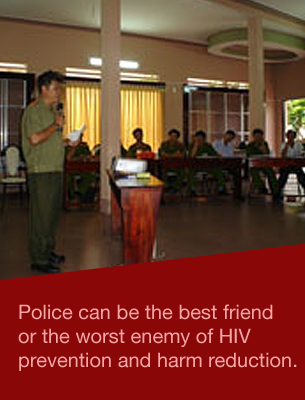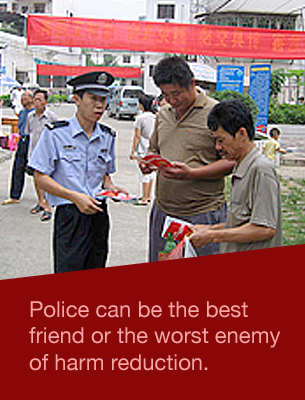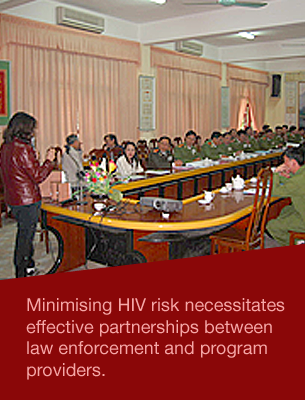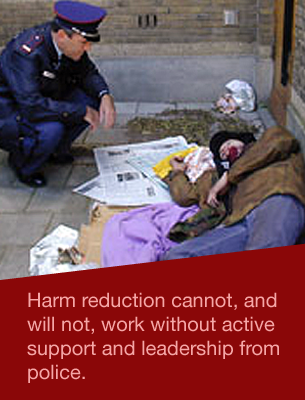New research from Leo Beletsky, JD, MPH, Associate Professor of Law and Health Sciences, Northeastern University School of Law & Bouvé College of Health Sciences
Introductory note from Leo Beletsky:
I am writing to share the news of research shedding new light on the role of police in shaping access to needle exchange programs published with colleagues from Johns Hopkins University and Baltimore City Health Department in a recent issue of the American Journal of Public Health.
As you know, police may be able to facilitate the work of public health programs. For instance, officers can refer potential clients about services available in their community, including syringe exchange and drug treatment facilities. As a rule, however, coordination between law and public health efforts in this and other realms is far from seamless.
Our research report “Police Encounters Among Needle Exchange Clients in Baltimore” offers stark evidence of police working at cross-purposes with syringe exchange and overdose prevention programs in Baltimore, US. Baltimore is a city where the success of drug user outreach has extremely high stakes: it has one of the highest rates of drug use-related HIV, hepatitis and overdose among its large population of people who inject drugs.
Clients of the city’s needle exchange report frequent police contact as they enter or exit the program. Even more troublingly, this research documents confiscation of syringes and other prevention supplies the needle exchange distributes. Such police activities can deter drug users from accessing prevention programs and increase syringe sharing. Our research also found that young program clients of color reported disproportionate amount of police contact. These data have special salience in the context of Baltimore’s simmering tensions between police and the African-American community.
Importantly, this lack of coordination is occurring despite important policy efforts to promote access to safe injection supplies. Maryland law shields exchange clients from criminal penalties for possession of syringes and other injection supplies. The City’s health and police departments have also formed an inter-agency agreement creating special enforcement protection zones around needle exchange sites.
We conclude that changing the law is sometimes necessary, but is often not sufficient to achieve public health goals. This research and similar findings from across the US and around the globe suggest that additional efforts like police training and management are necessary to ensure coordination between police and public health activities targeting drug users.
The article’s full text is available for download here.
Building on this research, we formulated a pilot police training initiative for Baltimore Police; an analysis of that effort is currently underway. NIDA also recently funded Steffanie Strathdee and I to conduct an analogous, but larger police training and evaluation effort to shift drug law enforcement practices in Tijuana, Mexico.
Thank you so much for your interest, and please let me know if you have any questions about this research.
Best, Leo
—
Leo Beletsky, JD, MPH
Associate Professor of Law and Health Sciences
Northeastern University School of Law & Bouvé College of Health Sciences
416 Huntington Avenue
Boston, MA 02115
P: 617.373.5540
F: 617-373-5056
E: l.beletsky@neu.edu
Faculty Scholar
Institute on Urban Health Research and Practice
Adjunct Professor
Division of Global Public Health, UC San Diego
Abstract
Police Encounters Among Needle Exchange Clients in Baltimore: Drug Law Enforcement as a Structural Determinant of Health
Authors: Leo Beletsky, JD, MPH, Jess Cochrane, JD, MPH, Anne L. Sawyer, MPH, Chris Serio-Chapman, BA, Marina Smelyanskaya, MPH, Jennifer Han, MPH, Natanya Robinowitz, MPH, and Susan G. Sherman, PhD, MPH
Objectives. We piloted a monitoring mechanism to document police encounters around programs targeting people who inject drugs (PWID), and assessed their demographic predictors at 2 Baltimore, Maryland, needle exchange program (NEP) sites.
Methods. In a brief survey, 308 clients quantified, characterized, and sited recent police encounters. Multivariate linear regression determined encounter predictors, and we used geocoordinate maps to illustrate clusters.
Results. Within the past 6 months, clients reported a median of 3 stops near NEP sites (interquartile range [IQR] = 0–7.5) and a median of 1 arrest in any location (IQR = 0–2). Three respondents reported police referral to the NEP. Being younger (P = .009), being male (P = .033), and making frequent NEP visits (P = .02) were associated with reported police stops. Among clients reporting arrest or citation for syringe possession, Whites were significantly less likely than non-Whites to report being en route to or from an NEP (P < .001). Reported encounters were clustered around NEPs.
Conclusions. Systematic surveillance of structural determinants of health for PWID proved feasible when integrated into service activities. Improved monitoring is critical to informing interventions to align policing with public health, especially among groups subject to disproportionate levels of drug law enforcement.
Read More: http://ajph.aphapublications.org/doi/abs/10.2105/AJPH.2015.302681




